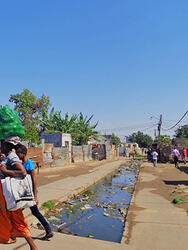Research Brief
A decade of growing inequality in Mozambique
Inequality in Mozambique increased substantially between 1996 and 2023, with a large and rapid increase between 2010–2020 of nearly 10 points on the Gini Index. A change of even 2 or 3 Gini points often represents major distributional changes in outcomes across the ranked groups of a population. A recent WIDER Working Paper examines the role of spatial inequalities—differences in outcomes between geographical areas—in driving this overall increase in inequality.
- Consumption inequality in Mozambique increased by nearly 10 Gini points between 2010 and 2020, peaking at Gini 51
- Growing disparities in household consumption between specific areas almost entirely drove this increase
- The growing divides were primarily between the rural north, especially Nampula province—with lower consumption—and the capital area—which nearly doubled its consumption
- Areas where consumption decreased more, relative to the average, were primarily affected by the impacts of a violent conflict, extreme weather events, non-inclusive economic growth, and an economic recession
- The consumption share of the Top 10% increased from 33% to 42% of total national consumption
The analysis covers data from six national household surveys conducted between 1996/97 and 2022/23 and measures inequality levels by household consumption. The analysis reveals that a dramatic increase in spatial inequality was the primary driver of the decade-long increase in inequality in Mozambique. Spatial inequality accounted for 33% of overall Gini inequality at its peak (up from 20% a decade earlier), explaining almost the entire increase.
2008 to 2015: Maputo, Tete, and Nampula
Between surveys conducted in 2008/09 and 2014/15, there was a generalized increase in consumption by Mozambican households, but the increase was much larger for urban households in Maputo and Tete provinces. Higher rates of consumption growth in these cities account for 72% of the observed increase in spatial inequality. Over the same period, some rural northern provinces saw consumption decline. The biggest decline in consumption—in Nampula province—explains an additional 15% of the increase.
2015 to 2020: A complex interplay
Between surveys conducted in 2014/15 and 2019/20, Mozambique faced several economic challenges—including an economic recession, violent conflict, and a series of natural disasters— which pushed household consumption into a generalized decline. Only one region, Tete province, saw consumption increase in parallel to the province’s strong economic growth, attributable, at least partially, to the discovery of coal deposits. Consumption fell more steeply in rural areas than in urban areas (excepting Maputo). The uneven drop in consumption explains 68% of the increase in spatial inequality in this period.
Figure 1: Consumption inequality in Mozambique (1996–2022)

There is no doubt that inequality has a substantial spatial dimension in Mozambique due to preexisting and recent geographical asymmetries—such as the unequal distribution of natural resources or the higher prevalence of natural disasters and conflicts in specific areas of the country. The much higher concentration of economic output in the capital, Maputo, and more recently to resource-rich Tete province, was the main source of growing spatial inequality in the period surveyed.
Extreme weather and violent conflict
The recent upward trend in inequality in Mozambique is linked to the country's vulnerability to extreme weather events. A series of cyclones, storms, and floods between 2015 and 2021 disrupted agricultural production, which is an important source of livelihood for many. Cyclone Chedza in 2015 damaged agricultural output in several provinces, including Tete, Manica, Sofala, and Maputo. In 2019, Cyclones Kenneth and Idai devastated production in Sofala, Zambezia, Manica, and Tete. The following year, a storm and flood further impacted Cabo Delgado, Nampula, Sofala, Zambezia, and Tete provinces. In 2021, Cyclone Eloise affected Sofala, Inhambane, and Manica, with some impact also felt in Nampula. These weather shocks create additional hardship for rural communities.
The violent conflict in northern Cabo Delgado province, which began in late 2017, has complex origins and greatly increased the number of internally displaced people, exacerbating the challenges faced by rural communities. Although it has complex roots, it is clear that deep spatial inequalities in Mozambique helped fuel the violent conflict, with experts attributing the violence to a complex mix of governance, security, political, and economic challenges.
The discovery of large gas reserves and ruby deposits in Cabo Delgado, with limited benefits for the local population, has contributed to feelings of marginalization and exclusion. The complex interplay between socioeconomic disparities and violent conflict highlights how deep historical and unresolved grievances can escalate into instability and further undermine efforts to reduce national inequality levels.
Recession, poverty, and vulnerability
An economic downturn in Mozambique began around 2015, triggered by a combination of factors, and amplified by a debt crisis stemming from the discovery of state-backed ‘hidden loans’ in 2016. The country’s vulnerability to commodity price fluctuations, particularly in coal and aluminum also played a role, leading to a depreciation of the Mozambican currency, a surge in inflation, a credit crunch, and reductions in both foreign direct investment and official aid.
The recession lowered real household consumption per capita, with median real consumption falling to levels below those seen in 1996/97. It contributed to a rise in the poverty rate, reversing some of the progress made in previous decades. The top 10% in Mozambique, by consumption, saw their consumption share rise from 33% to 42% between the 2008/09 and 2019/20 survey years, while the total share of consumption fell for the bottom population groups, who suffered disproportionately.
COVID-19 in Mozambique
- Efforts to arrest and reverse further growth in consumption inequality in Mozambique are needed to support successful national development
- Special attention needs to be given to reducing the geographic and socioeconomic concentration of economic growth
- Decreasing household vulnerability to consumption shocks can mitigate spatial inequality
- Long-term economic diversification and regional integration can reduce regional dependencies on primary sectors, which exhibit vulnerability to exchange rate and commodity market volatility and tend to concentrate economic benefits
This trend of increasing spatial inequality was interrupted in the post-pandemic period, but not for reasons most would celebrate. Notably, the pandemic disproportionately affected Maputo and Tete, reversing economic gains which had earlier been a source of growing inequality. While these reversals resulted in the first substantial reduction in consumption inequality in a decade, this effect may only be temporary.
These findings are useful in understanding the future trajectory of inequality in Mozambique. The country is poised to resume a strong economic growth path. However, if growth continues to be concentrated geographically and socioeconomically, as observed in the past, Mozambique might experience another decade of growing inequality.
 Join the network
Join the network